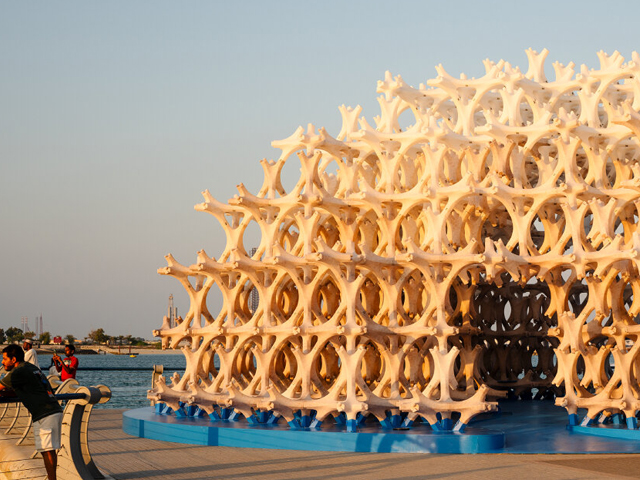UNUSED HOUSING ESTATE YARD TRANSFORMED INTO COPENHAGEN'S NEWEST CLIMATE PARK
05 Feb 2025
Danish nature-based design studio SLA has transformed the 20,000 m2 outdoor areas of Grønningen-Bispeparken – a Danish 1950s social housing estate - into a new climate park. The housing estate's public spaces of derelict, unsafe and barren grass lawns are now secured against thunderstorms and flooding while also adding social, biological and cultural values to the neighborhood.

Text description provided by the architects. Danish nature-based design studio SLA has transformed the 20,000 m2 outdoor areas of Grønningen-Bispeparken – a 1950s social housing estate. The task was to transform the housing estate's public spaces from derelict, unsafe, and barren grass lawns into a new climate park that would secure the area against thunderstorms and flooding while also adding social, biological, and cultural values to the neighborhood. To address these challenges, SLA designed Grønningen-Bispeparken to be Copenhagen's most radical nature-based climate adaptation project to date. By letting the form of the park follow nature, SLA created an interconnected series of 18 bioswales throughout the sloping park that can collect, contain, and infiltrate more than 3,000 m3 of rainwater falling in the park and the adjacent courtyards and streets.

The park features five main nature typologies designed according to their climate and social functions: the wet Bio Oases where nature and wildlife have the right of way; the small, dry biotopes Between the Trunks for intimate play and relaxation; the larger, dry Common Lawns for sports, farmer's markets, community dinners, and events; the small, urban Pocket Squares for informal stay and socializing between the buildings; and The Bunker Hills that transform the park's Cold War underground bunkers into flexible social places – from catching the evening sun in the summer to sledding and skiing in the winter. By combining climate challenges with social and cultural opportunities, the bioswales double as 'social swales' providing the park with a host of playful, nature-rich, and safe meeting places for community and togetherness.

A meandering path of gravel and yellow tile (a nod to the iconic neighboring Grundtvig's Church) knits together the park's different typologies and is designed to draw people out into the park to experience the city's nature design up close. Designed to be an inviting, all-year-round neighborhood asset for the local residents, Grønningen-Bispeparken adds 149 trees of 23 different species and more than 4 million planting seeds of specially crafted seed mixtures. All new trees and plants are native species to preserve and enhance the local biodiversity.

Alongside the design of the new park, the National Arts Council of Denmark commissioned the artist Kerstin Bergendal to a four-year experimental art intervention. Her project, 'Concerning A Meadow', unfolded in a glitch between spatial planning, citizens' engagement, and a new mandate for public art. As such, it offered the city's planners, SLA's internal Social Design Team, and local residents a parallel process for the unplanned and informal knowledge exchange regarding the park. Kerstin Bergendal also added a series of wooden art structures to the park, elaborated in collaboration with the small landscape studio Efterland. The art structures are seamlessly integrated into the park's natural fabric, giving children as well as adults varied opportunities for play, exercise, and socializing on the wooden art elements.

The park was inaugurated on August 31, 2024. Only five days later, a major thunderstorm hit Copenhagen flooding several major highways and infrastructures. But in Grønningen- Bispeparken, the heavy rain only made the new park more sensuous and lush – while the surrounding houses and infrastructures remained safe and dry. All proves that in Grønningen-Bispeparken, rain is not seen as a threat – but as a natural resource to be celebrated.

Grønningen-Bispeparken Climate Park
LOCATION Copenhagen, Denmark
ARCHITECT SLA
PHOTOGRAPHY SLA, Mikkel Eye, Marie Damsgaard, Københavns Kommune

MORE NEWS

DIXON PARK ESCARPMENT LOOKOUT PROVIDES VIEWS OF PARRAMATTA CITY

THE GREEN LUNG OF JINGYUE

FLEETWOOD URBAN REBRANDS AS FORGE

XI'AN'S CULTURAL DISTRICT TAKES DESIGN CUES FROM ITS CERAMIC HERITAGE

SUSTAINABLE PRACTICES IN PUBLIC ART IN DUBAI

